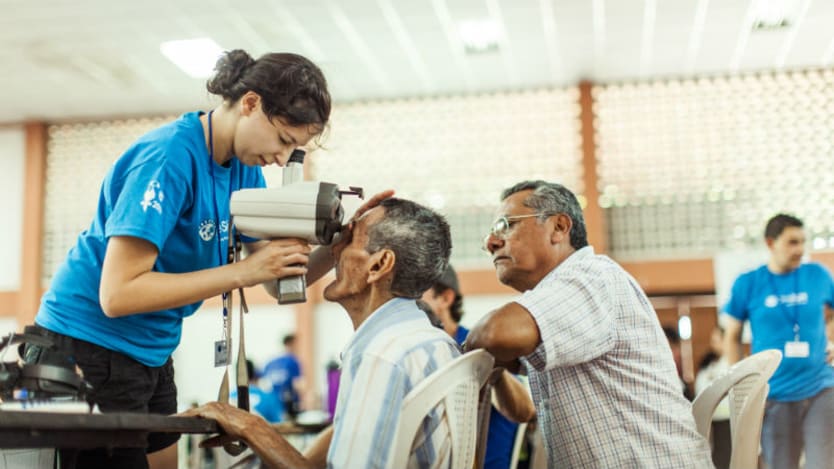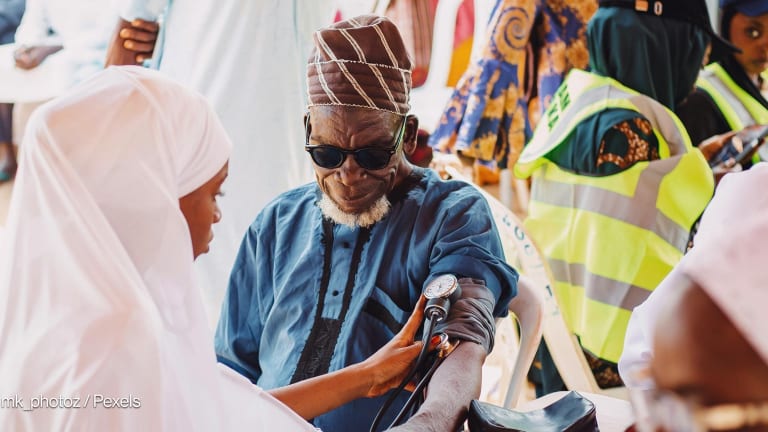
MANILA — In one of Thailand’s so-called “temporary shelters” for ethnic minorities displaced from Myanmar, over 2,000 people lined up over the past two weeks to get an eye exam.
One of them was a school bus driver who received his very first pair of glasses, after years of driving without one, said Maud Zeller, South and Southeast Asia program manager for OneSight, a charity that runs an eye clinic at the temporary shelters.
“He never really had access to eye care before, but he knew his vision was impaired,” Zeller said. “He said to us, ‘thank God, I’m going to breathe again … [because] if something happened, it’s me plus these [24] children in the bus.’”
► Using skills-based training as a tool for inclusion
There were over 70 million people forcibly displaced by the end of 2018, a record number and a 2.3 million increase from 2017. This is likely a conservative estimate, given the ongoing crisis in Venezuela, according to the UN Refugee Agency. As numbers increase, so do the needs. The current global funding requirement for humanitarian crises is at $26.4 billion, but coverage is so far just at 18.6%, according to Humanitarian Insight.
Assistance typically includes addressing basic needs — food, water and sanitation facilities, education initiatives, and health care. But there are other needs that are sometimes overlooked.
Clear vision is one of those: Addressing visual impairment can help change a person’s day-to-day well-being. The elderly can maintain their independence from family or community members for longer, a child can perform and participate better in class activities, and employees can do better in their workplace.
But in the humanitarian sector, funding is always a struggle. In Cox’s Bazar, Bangladesh, where there are ongoing needs, a joint response plan launched last February 2019 is currently only 25% funded. The International Agency for the Prevention of Blindness, an alliance of organizations, businesses, and professional bodies promoting eye health, conducted a rapid assessment of avoidable blindness, or RAAB, with support from eye care charity the Seva Foundation, to gain a better understanding of the need for eye care services.
“When you have a big humanitarian crisis, like the Rohingya [for example], initially on the short term, a lot of money comes in ... individual donors are making donations and it captures a lot of attention for a really brief amount of time,” said Dr. Jerry Vincent, refugee eye consultant for the Seva Foundation, which is based in California, United States.
“But you know, the Rohingya are already old news and the international press has gone on to other things. So it's going to be increasingly difficult to kind of fund things there,” he said.
Organizations must prioritize and ensure they cover the most basic, but lifesaving interventions.
“You could list out 10 things that you should do, but there just isn't the expertise within the humanitarian side or the money or the energy and space to kind of make it happen,” he said.
Historically, he added, most eye organizations operate outside of the humanitarian space, working instead in more stable governments where there’s room to build local capacity to provide eye care services. But that is increasingly changing, he explained.
Eye care in displaced settings
In Cox’s Bazar, currently the largest refugee camp in the world with over 900,000 people, there’s now a consortium of aid agencies that include eye care organizations working together to help address the eye health needs of both the host population and Rohingya refugees.
“It's not like we can go into the Rohingya [camps], do a bunch of cataract surgery now, and then it's done, because every year people will develop cataracts.”
— Dr. Jerry Vincent, refugee eye consultant, Seva FoundationIAPB conducted a situational analysis of eye care and eye services in the district in June 2018, where they initially estimated over 150,000 pairs of eyeglasses would need to be provided in the district each year. Up to 30,000 people are also at risk of diabetic eye disease, and nearly 70,000 could develop glaucoma.
Against these needs, they found there was only one eye facility in the district. The national eye care plan is for the district hospital to have an eye operating theater, and to have 30 ophthalmologists and 30 optometrists serving both populations. But the organization found the district hospital was not providing eye surgeries, there were no vision centers, and “only a handful” of ophthalmologists and optometrists.
Following the RAAB IAPB carried out, there are plans to follow up with another survey sometime in September, this time to capture vision problems among individuals aged 15-49. The RAAB survey focused mostly on those aged 50 and above, Vincent explained, who is also involved in the survey.
OneSight, initially the charity arm of a private eyewear company until a few years ago when it became an independent nonprofit organization, has also started working in displaced communities.
The charity has traditionally focused in more stable environments where access to eye care including eyeglasses is lacking. The organization partners with governments or local entities to open “vision centers.”
These are often set up in affiliation with district hospitals. They train local personnel in different areas, from providing eye care to managing operations. Here, members of communities can come in and get comprehensive eye screening and purchase prescription glasses at affordable rates. If they were found to have other eye-related issues, such as glaucoma or cataract, for example, they receive a referral for further care, as available.
“What’s really beautiful about this model is that … when we leave, we’ve got a self-sustaining vision center that provides access to the community as well as having created jobs locally and built capability,” said K-T Overbey, the charity’s president and executive director.
But in less stable environments, where the infrastructure is often nonexistent, OneSight has started running charitable clinics where it operates for a few weeks at a time, bringing in volunteers and a full manufacturing laboratory.
Similar to the vision centers, these clinics are staffed to provide communities with eye screening tests and prescription glasses or referrals. While OneSight missions in these settings are short-term, Overbey said the organization tries to look for partners that work in the area that can continue what they’ve started.
In Thailand, the charity is working with the International Rescue Committee and the Mae Tao Clinic, a permanent facility that has been in operation there for years, to provide these eye services to displaced communities living on the border.
In 2019, the charity plans to run other charitable clinics in Colombia and Tanzania. It is also currently looking at how it can provide similar services in Cox’s Bazar.
Focus on: Vision around the globe
► Nigeria's biggest cause of permanent blindness is failing to attract attention
► How India became a leader in low-cost, high-quality eye care
► In Ethiopia, a multipronged approach to tackle avoidable blindness
“Having the opportunity to have gone into Cox’s, what struck me was purely the volume of people that was actually in that particular camp at the time. There’s like three-quarters of a million people in there, and the conditions that these people are actually living in … they’re really just getting through day by day,” said Wayne Tennent, OneSight program director for Asia-Pacific.
“I totally understand that there are other health needs that are more urgent. But absolutely, there’s an opportunity for us to be able to work in those types of communities,” he said, adding that hopefully they can have a program there up and running by the first or second quarter of 2020.
The long-term challenge
But while there may now be more eye care organizations coming together to offer their services among displaced communities, the challenge is doing it in the long-term.
Cataracts and lack of access to corrective measures such as eyeglasses are the biggest causes of blindness and vision loss, respectively, in most low- and middle-income settings — and also in refugee populations, Vincent explained.
“Regardless of how much glaucoma you might have or diabetic retinopathy or whatever else, those two problems alone are going to make up probably 80%, maybe even 90% of all eye problems,” he said.
In camps for refugees and displaced people where OneSight works, often 80% of patients prescreened by partners or by the organization itself require glasses. Along the Thailand-Myanmar border where the charity recently conducted a mission, the need was even greater at around 90% of prescreened patients, according to OneSight’s Zeller.
But addressing these problems means organizations need a consistent source of funding.
“[Funding] needs to be there every year as long as the refugees are there. And a lot of donors will give you money for one year or three years or whatever, some sort of short timeframe. And maybe you can roll that over for a second chance or a third chance. But at a certain point, donors are just going to get tired of saying, look, every year we give you $100,000 to do cataract surgery and provide eyeglasses for this population,” Vincent said.
“It's not like we can go into the Rohingya [camps], do a bunch of cataract surgery now, and then it's done, because every year people will develop cataracts,” he explained.
Devex, with financial support from our partner Essilor, is exploring challenges, solutions, and innovations in eye care and vision. Visit the Focus on: Vision page for more.






